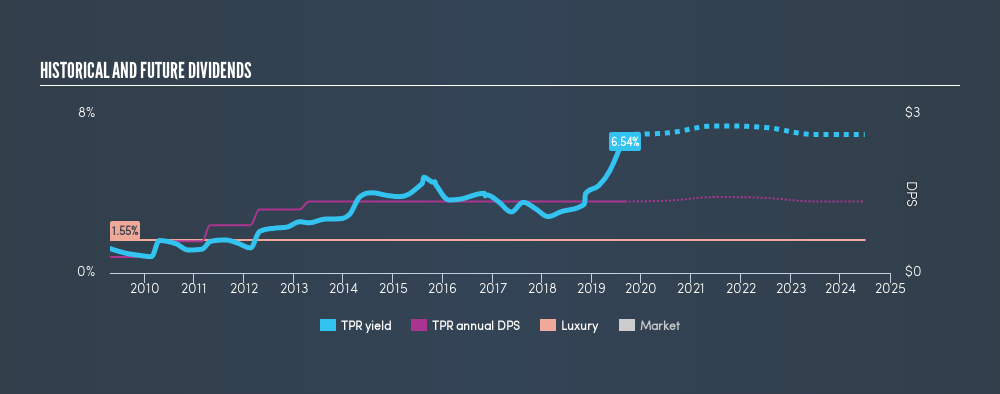- United States
- /
- Luxury
- /
- NYSE:TPR
We Wouldn't Be Too Quick To Buy Tapestry, Inc. (NYSE:TPR) Before It Goes Ex-Dividend

Some investors rely on dividends for growing their wealth, and if you're one of those dividend sleuths, you might be intrigued to know that Tapestry, Inc. (NYSE:TPR) is about to go ex-dividend in just 3 days. You will need to purchase shares before the 5th of September to receive the dividend, which will be paid on the 30th of September.
Tapestry's next dividend payment will be US$0.34 per share, on the back of last year when the company paid a total of US$1.35 to shareholders. Looking at the last 12 months of distributions, Tapestry has a trailing yield of approximately 6.5% on its current stock price of $20.65. Dividends are a major contributor to investment returns for long term holders, but only if the dividend continues to be paid. So we need to check whether the dividend payments are covered, and if earnings are growing.
View our latest analysis for Tapestry
Dividends are typically paid out of company income, so if a company pays out more than it earned, its dividend is usually at a higher risk of being cut. Tapestry is paying out an acceptable 61% of its profit, a common payout level among most companies. Yet cash flows are even more important than profits for assessing a dividend, so we need to see if the company generated enough cash to pay its distribution. Over the last year, it paid out more than three-quarters (75%) of its free cash flow generated, which is fairly high and may be starting to limit reinvestment in the business.
It's positive to see that Tapestry's dividend is covered by both profits and cash flow, since this is generally a sign that the dividend is sustainable, and a lower payout ratio usually suggests a greater margin of safety before the dividend gets cut.
Click here to see the company's payout ratio, plus analyst estimates of its future dividends.

Have Earnings And Dividends Been Growing?
When earnings decline, dividend companies become much harder to analyse and own safely. Investors love dividends, so if earnings fall and the dividend is reduced, expect a stock to be sold off heavily at the same time. That's why it's not ideal to see Tapestry's earnings per share have been shrinking at 4.6% a year over the previous five years.
Many investors will assess a company's dividend performance by evaluating how much the dividend payments have changed over time. In the past ten years, Tapestry has increased its dividend at approximately 16% a year on average. Growing the dividend payout ratio while earnings are declining can deliver nice returns for a while, but it's always worth checking for when the company can't increase the payout ratio any more - because then the music stops.
Final Takeaway
Is Tapestry an attractive dividend stock, or better left on the shelf? While earnings per share are shrinking, it's encouraging to see that at least Tapestry's dividend appears sustainable, with earnings and cashflow payout ratios that are within reasonable bounds. It's not that we think Tapestry is a bad company, but these characteristics don't generally lead to outstanding dividend performance.
Wondering what the future holds for Tapestry? See what the 26 analysts we track are forecasting, with this visualisation of its historical and future estimated earnings and cash flow
A common investment mistake is buying the first interesting stock you see. Here you can find a list of promising dividend stocks with a greater than 2% yield and an upcoming dividend.
We aim to bring you long-term focused research analysis driven by fundamental data. Note that our analysis may not factor in the latest price-sensitive company announcements or qualitative material.
If you spot an error that warrants correction, please contact the editor at editorial-team@simplywallst.com. This article by Simply Wall St is general in nature. It does not constitute a recommendation to buy or sell any stock, and does not take account of your objectives, or your financial situation. Simply Wall St has no position in the stocks mentioned. Thank you for reading.
About NYSE:TPR
Tapestry
Provides luxury accessories and branded lifestyle products in North America, Greater China, rest of Asia, and internationally.
Average dividend payer and fair value.
Similar Companies
Market Insights
Community Narratives





